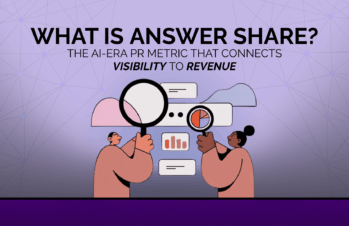You can’t predict when a crisis will strike—but you can always prepare for one.
However, for whatever reason, many B2B companies don’t prepare for the inevitable crisis, which leaves them scrambling when it’s time to talk to the press about a faulty gadget or a change in leadership.
Pro tip: You will always, always come out better off if you have a crisis communications plan BEFORE a crisis strikes.
With that in mind, let’s get into how to create a crisis communications plan. Here we go!
First, what qualifies as a “crisis” for B2B companies?
Let’s begin with the basics: what exactly qualifies as a crisis for a B2B brand?
To define it: a crisis is a situation that is threatening enough to a business that it can create potential long-term damage to the business’s reputation, operations, or overall stability.
That could mean anything from a serious glitch in a product to an executive’s financial malfeasance.
In a crisis situation, time is of the essence. A measured, yet speedy response is required so you can deliver the facts and prevent potential misconceptions before the rumor mill, the media, and your stakeholders get a hold of the story and start speculating.
And this is why B2B crisis communication is such a specific discipline within the broader context of strategic public relations. It requires a different set of skills and know-how, and there are even dedicated crisis communication agencies.
We’ll talk about how to react to a crisis when one strikes in a bit, but first, let’s talk about the most important part of crisis management: preparation.
How to Prepare a B2B Crisis Management Plan

The first step to being ready for a crisis is to have your crisis management plan prepared, documented, and accessible to anyone who would need it. You can work off of a digital crisis management plan template or create your own plan by following the steps below.
With that in mind, what should go into your crisis management plan?
- Identify the crisis management team.
Who will be in charge of crisis communications in the event of a crisis? You need a team of people who are knowledgeable, trained, and good at public speaking. The leader of this team, at least in the public eye, must be a member of the C-suite and preferably the CEO. If not, your B2B brand runs the risk of looking as though it’s trying to shield the executives or avoid accountability.
Other members of the team should include your top PR professional, either in-house or from your PR agency, a legal counsel, and the heads of your major divisions or departments. Depending on the crisis, not every department head will need to be involved—but each one should be ready to go in case the crisis in question has to do with their team or department function.
- Designate a spokesperson.
Decide in advance who will be the person (or people) responsible for speaking to the media, who will be responsible for speaking to clients, and who will be responsible for speaking to other stakeholders, if necessary.
If this person is in need of media training, you can easily obtain it either through your B2B PR agency or through another training organization.
Make sure this information is disseminated throughout your organization. This way, if employees are contacted by the media or by clients during a crisis, they can direct those requests to the right individuals.
- Develop a contact list of news media, agency or government officials, and other entities that should be contacted.
Create a spreadsheet with the contact information for various journalists, compliance officials, government officials, and others in the public sphere who should be notified immediately when a crisis hits.
This is critical to keep your response as swift as possible—ideally, you want your spokesperson to be the one letting the media know what happened, rather than having to set the record straight after the fact. Crises only get worse when a company tries to downplay what’s happening or is slow to notify the proper officials. Your B2B communications team should be the one to initiate the response.
- Make a list of the people who need to be personally contacted.
Major clients, board members, important suppliers and vendors—these are some of the stakeholders in your B2B business who stand to be affected by the crisis, and they should be personally contacted by a member of the C-suite.
Make sure to be transparent about what happened, able to explain what steps are being taken, and ready to answer their questions. It’s helpful to have your top PR professional either on the call as well, or nearby to assist with answering questions as needed.
- Designate a folder, server, etc. where your digital crisis communications will be housed and make them accessible to your crisis team.
There’s nothing like desperately searching through Google Drive to find the right crisis statement to make responding to a crisis even more stressful. Make sure your crisis communications templates, responses, contact lists, and any other necessary documentation are housed in one location where everyone who needs them can quickly access them. This should be separate from your other business communications.
It’s also important to ensure that any old or outdated information is removed in a timely manner. Keep your documents updated, and note the updating date on each individual file.
- Run a test situation.
One thing that veteran B2B PR agencies know all too well is that most people forget what the plan says and just react in a crisis.
This is why running test scenarios can be so helpful. If your team has gone through the motions before, they’re more likely to remember to go to the plan immediately, and they’ll also feel more confident executing it when the time comes. It may also be helpful to ask your PR firm for crisis communication examples to inform your own execution.
Many brands never conduct this part of crisis preparation, but doing so can reassure everyone that the plan is working, or identify steps or areas that need to be reevaluated. Either way, your team is better prepared, and your brand comes out with stronger crisis preparedness.
Related post: 10 PR Mistakes to Avoid at All Costs: B2B Edition
How to react to a B2B brand crisis, step by step
So let’s say the crisis actually hits.
For example, it’s a glitch in your CRM software that’s affected your customers’ data security. A customer contacted you, let you know something strange was happening, and you sent your IT team into investigation mode.
They then confirmed that yes, there was a glitch and it needed to be patched.
Now you’re being contacted by tens of other customers having the same problem.
Step 1: Have the CEO or CTO respond publicly. Acknowledge the issue, own the mistake, and be transparent about what is being done and how it’s being fixed. Assure the public that further updates will be made as necessary. This is where your contact list of journalists, officials, and others will be used.
Step 2: Have your sales or account team contact each customer to let them know of the situation and make amends (offering discounted services, etc.). Contact every customer, even if you haven’t heard from them yet. Being proactive with customer service is key here.
Step 3: Create an online communication portal where those who have questions can find answers. This could be in the form of an FAQ page, a microsite dedicated exclusively to crisis response, or a special social media profile that you update regularly. If you’re going to use a dedicated social media account, you need to be able to update frequently—at least every hour. That’s what followers will expect.
Step 4: Keep your brand’s social media profiles updated and closely monitored for complaints or feedback. Respond as quickly as possible to every complaint, and direct people to your online portal for more information.
Step 5. Repeat as necessary, keeping the media, clients, and your business partners updated as the situation changes.
A crisis can put even the most established brands into an extremely vulnerable position. Make sure your brand is prepared. If you need help developing your B2B crisis management plan, get in touch!




